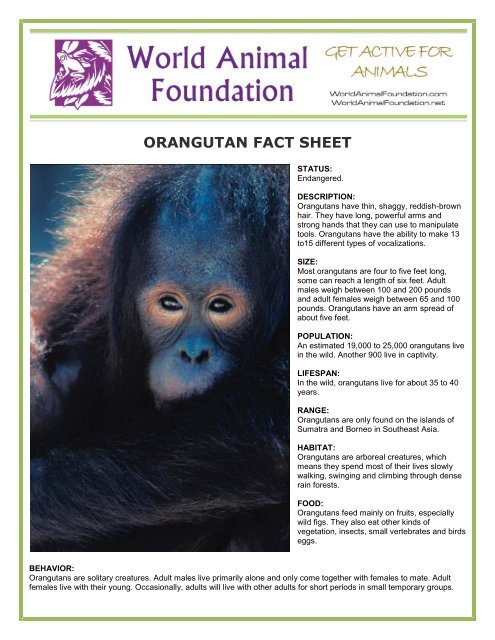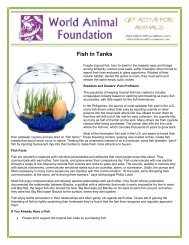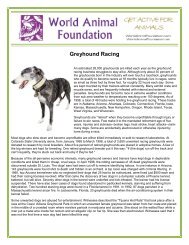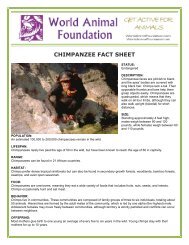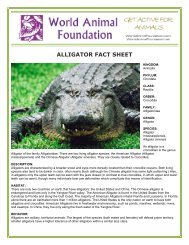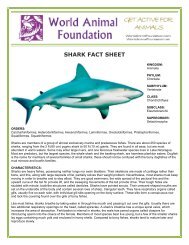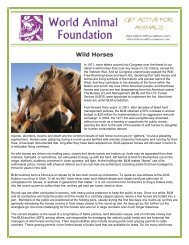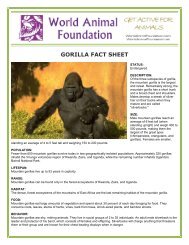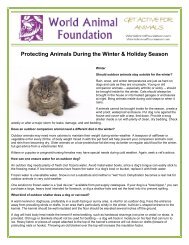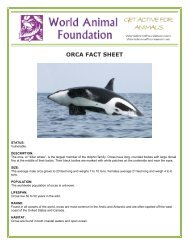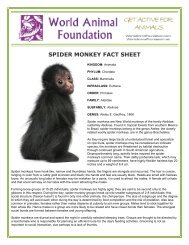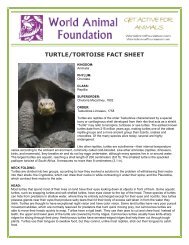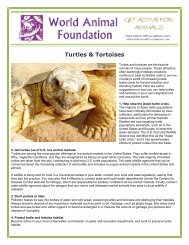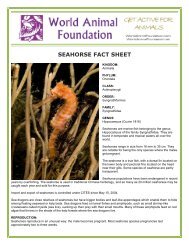ORANGUTAN FACT SHEET - World Animal Foundation
ORANGUTAN FACT SHEET - World Animal Foundation
ORANGUTAN FACT SHEET - World Animal Foundation
You also want an ePaper? Increase the reach of your titles
YUMPU automatically turns print PDFs into web optimized ePapers that Google loves.
<strong>ORANGUTAN</strong> <strong>FACT</strong> <strong>SHEET</strong><br />
STATUS:<br />
Endangered.<br />
DESCRIPTION:<br />
Orangutans have thin, shaggy, reddish-brown<br />
hair. They have long, powerful arms and<br />
strong hands that they can use to manipulate<br />
tools. Orangutans have the ability to make 13<br />
to15 different types of vocalizations.<br />
SIZE:<br />
Most orangutans are four to five feet long,<br />
some can reach a length of six feet. Adult<br />
males weigh between 100 and 200 pounds<br />
and adult females weigh between 65 and 100<br />
pounds. Orangutans have an arm spread of<br />
about five feet.<br />
POPULATION:<br />
An estimated 19,000 to 25,000 orangutans live<br />
in the wild. Another 900 live in captivity.<br />
LIFESPAN:<br />
In the wild, orangutans live for about 35 to 40<br />
years.<br />
RANGE:<br />
Orangutans are only found on the islands of<br />
Sumatra and Borneo in Southeast Asia.<br />
HABITAT:<br />
Orangutans are arboreal creatures, which<br />
means they spend most of their lives slowly<br />
walking, swinging and climbing through dense<br />
rain forests.<br />
FOOD:<br />
Orangutans feed mainly on fruits, especially<br />
wild figs. They also eat other kinds of<br />
vegetation, insects, small vertebrates and birds<br />
eggs.<br />
BEHAVIOR:<br />
Orangutans are solitary creatures. Adult males live primarily alone and only come together with females to mate. Adult<br />
females live with their young. Occasionally, adults will live with other adults for short periods in small temporary groups.
Orangutans spend most of their lives in a "home<br />
range" of 0.4 to 3.7 square miles. Females have a<br />
smaller home range than males. Sometimes the<br />
home ranges of individual orangutans overlap.<br />
OFFSPRING:<br />
Females are able to give birth after age seven, but in<br />
the wild they generally do not mate until age 12.<br />
They give birth to one young at a time, which clings<br />
to its mother’s stomach until it is about a year old.<br />
When an orangutan reaches adolescence at about<br />
four or five years, it becomes more independent but<br />
may seek protection from its mother until it reaches<br />
seven to eight years.<br />
THREATS:<br />
The orangutan’s most serious threat is the<br />
destruction of forest habitat from excessive logging. Female orangutans are also killed and their young are taken and<br />
illegally placed in circuses and zoos. Orangutans are highly endangered in the wild. Orangutan habitat destruction due to<br />
logging, mining and forest fires has been increasing rapidly in the last decade. Much of this activity is illegal, occurring in<br />
national parks that are officially off limits to loggers, miners and plantation development. There is also a major problem<br />
with the illegal trapping of baby orangutans for sale into the pet trade; the trappers usually kill the mother to steal the<br />
baby.<br />
CAPTIVITY:<br />
Performing captive wildlife -- elephants, lions, tigers, bears, baboons, monkeys, camels, llamas - all endure years of<br />
physical and psychological pain and suffering in traveling acts to "entertain" an uninformed audience. <strong>Animal</strong>s used in the<br />
circus and other traveling acts travel thousands of miles each year without water, in railroad cars or trucks not air<br />
conditioned in summer or heated in winter.<br />
Despite their professed concern for animals, zoos remain more "collections" of interesting "items" than actual havens or<br />
simulated habitats. Zoos teach people that it is acceptable to keep animals in captivity, bored, cramped, lonely, and far<br />
from their natural homes.<br />
Zoos claim to educate people and preserve species, but they frequently fall short on both counts. Most zoo enclosures are<br />
quite small, and labels provide little more information than the species' name, diet, and natural range. The animals' normal<br />
behavior is seldom discussed, much less observed, because their natural needs are seldom met. Many animals who<br />
naturally live in large herds or family groups are often kept alone or, at most, in pairs. Natural hunting and mating<br />
behaviors are virtually eliminated by regulated feeding and breeding regimens. The animals are closely confined, lack<br />
privacy, and have little opportunity for mental stimulation or physical exercise, resulting in abnormal and self-destructive<br />
behavior, called zoochosis.<br />
Zoo babies are great crowd-pleasers, but what happens when babies grow up? Zoos often sell or kill animals who no<br />
longer attract visitors. Deer, tigers, lions, and other animals who breed often are sometimes sold to "game" farms where<br />
hunters pay for the "privilege" of killing them; some are killed for their meat and/or hides. Other "surplus" animals may be<br />
sold to smaller, more poorly run zoos or to laboratories for experiments.<br />
INTELLIGENCE:<br />
Like the other great apes, orangutans are remarkably intelligent. Although tool use among chimpanzees was documented<br />
by Jane Goodall in the 1960s, it wasn't until the mid 1990s that one population of orangutans was found to use feeding<br />
tools regularly.<br />
PROTECTION:<br />
Endangered Species Act, CITES* Appendix I<br />
*Convention on International Trade in Endangered Species of Wild Fauna and Flora, an international treaty with more<br />
than 144 member countries. Appendix I listed species cannot be traded commercially. Appendix II listed species can be<br />
traded commercially only if it does not harm their survival.


